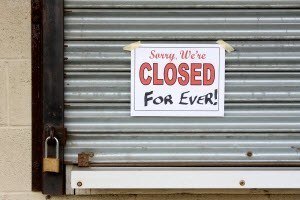 The last few months have seen further high profile UK businesses announcing that they have entered administration. Comet, Jessops, HMV and Blockbuster have been the most recent of a line of high street retailers going under.The company directors themselves, news channels, press and media were quick to blame a variety of factors, including the growth of Internet shopping.
The last few months have seen further high profile UK businesses announcing that they have entered administration. Comet, Jessops, HMV and Blockbuster have been the most recent of a line of high street retailers going under.The company directors themselves, news channels, press and media were quick to blame a variety of factors, including the growth of Internet shopping.
Whilst there was an increase in overall retail sales in December 2012, of 1.5% compared to the previous year, the British Retail Consortium said that this was due to online shopping bolstering the figure by contributing 17.8% growth in non-food eCommerce sales.
High Street vs Internet
The obvious differences between running a high street store and an online store are the additional costs of overheads, property, staffing and logistics. But what about eCommerce sites? They have their fair share of costs: website administration/content, marketing, customer service and postage administration for example.
For many businesses, their website (if they even have one) is seen as a secondary source of custom, when really they should be focusing more attention on it. It should be considered the primary source of custom, as more people are potentially able to shop online than visit any single shop. Currently, online retail only accounts for around 10% of all retail sales.
Adapting to Trends
 With the consistent growth in online shopping over the past few years, it’s said that some high street retailers have invested too much in retail property and not enough in online. I’d have to agree on this. If retailers have not recently invested in eCommerce, then it could be a little too late. I believe the slow response to adapt in any retail environment can lead to failure. Comet, Jessops, HMV and Blockbuster all had nice eCommerce solutions, but were they good enough or were they behind the times?
With the consistent growth in online shopping over the past few years, it’s said that some high street retailers have invested too much in retail property and not enough in online. I’d have to agree on this. If retailers have not recently invested in eCommerce, then it could be a little too late. I believe the slow response to adapt in any retail environment can lead to failure. Comet, Jessops, HMV and Blockbuster all had nice eCommerce solutions, but were they good enough or were they behind the times?
Blockbuster is a good example. They were not the first to launch online DVD rental, however they did expand into sales of new products and even opened an online marketplace for customers to sell their DVDs and Games. They even have a ‘Click & Collect’ service, but all this it seems hasn’t been enough to pay the bills. Companies like LoveFilm saw the opportunity for online DVD rental and utilised the low cost of online to succeed and get snapped up by the online retail giant, Amazon. Blockbuster missed a huge opportunity whilst they were the leaders in the DVD rental sector.
So with the diversification into online and good website performance, the failure to be first with new opportunities, plus the overheads of retail properties added up.
Successful Operations
Retailers such as John Lewis saw growth in its stores, as well as online. The biggest increase was of course from online, around 40% in their most recent sales figures. Managing Director of John Lewis, Andy Street explained that their investment into online had paid off last December (2012). In particular, they launched a click and collect service so that customers can pick up their products at their own stores plus Waitrose stores, making it more convenient for customers to get their items. This is a trend happening across other big name brands too; Tesco, ASDA and more recently Argos. But the biggest thing that stood out for me was the use of the word ‘convenience’.
Convenience
Convenience is a big deciding factor for online retail. It’s easy to go to an online shop, it’s now even easier to get your goods quickly via click and collect, but convenience also means making it easy to convert website visitors to customers.
Spending every minute of the day testing and refining their website led Amazon to the top position for online retail. Every retailer should be doing this. Conversion Rate Optimisation is the term used to test these factors. It includes analysing and changing shopping cart to purchase funnels, as well as changing elements on the website pages in order to increase the chances of products being selected and purchased.
Diversification
The other big factor in online retail is diversification. Laura recently talked about Diversification in an online sense. High street retailers are well practiced with the tricks and techniques to get people into their stores but what about online? They need to invest in social; Facebook, Twitter, Google+, YouTube and Pinterest are some of the social sites that get huge traffic numbers, so getting a fraction of these visitors to come to their website is vital to online growth and success. If traditional retail brands don’t invest and innovate in social, then someone else will have the advantage.
Where Are We Heading?
Click and collect could be the future, it’s certainly helped the likes of John Lewis and Argos enormously in recent months. It saves on any potential delivery issues and gives a new purpose to the high street premises. This also attracts many shoppers wary of buying goods electronically, as they will have a store to return items to if they aren’t as expected.
Automated warehouse picking machines is one form of technology that is being invested in recently and could revolutionise the eCommerce sector. It primarily means less staffing costs and increased productivity. But this is also likely to cause higher unemployment which can affect sales as a result of the cycle.
Analysts are predicting the continued failure of high street brands in the near future. However, I believe they can survive, although they need to be lean and adaptive, constantly on the lookout for new trends. The consumer world moves so quick in this day in age, which is due to the expansion in technology and increased social communication. This means that the Internet plays a huge part in the future of retail, whether brands operate online or primarily on the high street.
It’s not all doom and gloom for the high street, some brands such as Primark saw sales jump by a quarter in the last three months of 2012. During that period they opened 14 new stores worldwide. What’s surprising is that Primark don’t have an eCommerce solution. I guess they have got their branding and product appeal just right for the high street.
How do you see the future of the high street and how much of a part has the Internet been in the demise of big brand names? Let me know your thoughts in the comments section below.
Image Credit: Bankrupt Business from BigStock Photo





Leave a Reply